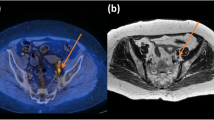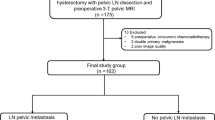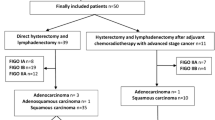Abstract
Purpose
To evaluate the diagnostic value of diffusion-weighted MR imaging for differentiating metastatic and hyperplastic pelvic lymph nodes in patients with cervical carcinoma.
Materials and methods
In this prospective study, 61 untreated patients were scanned with both morphological MR and diffusion-weighted imaging (DWI). Bilateral pelvic lymphadenectomy was then performed in all patients. Of the 1118 total dissected and histopathologically evaluated pelvic lymph nodes, 153 enlarged nodes with short-axis diameter larger than 5 mm were included for further study. The mean ADC values of all enlarged lymph nodes and the relative ADC values between tumors and nodes were also measured and, respectively, compared between the metastatic and hyperplastic node groups.
Results
The mean ADC value of metastatic [(1.046 ± 0.198) × 10−3mm2/s] nodes was significantly lower than that of hyperplastic [(1.289 ± 0.194) × 10−3mm2/s] nodes (P < 0. 001). The relative ADC values between tumor and nodes were significantly lower in malignant [(0.19 ± 0.17) × 10−3mm2/s] than hyperplastic [(0.4 ± 0.21) × 10−3mm2/s] nodes (P < 0. 001). When a mean ADC value of 1.15 × 10−3mm2/s was used as a threshold value for differentiating metastatic from hyperplastic nodes, the best results were obtained with a sensitivity of 83.3%, specificity of 74.7%, and accuracy of 78.4%.
Conclusion
DWI is useful in differentiating metastatic and hyperplastic pelvic lymph nodes in patients with cervical carcinoma.







Similar content being viewed by others
References
Halefoglu AM, Yildirim S, Avlanmis O, et al. (2008) Endorectal ultrasonography versus phased-array magnetic resonance imaging for preoperative staging of rectal cancer. World J Gastroenterol 14:3504–3510
Cheung TH, Lo WK, Yu MY, et al. (2004) Extended experience in the use of laparoscopic ultrasound to detect pelvic nodal metastasis in patients with cervical carcinoma. Gynecol Oncol 92:784–788
Choi HJ, Roh JW, Seo SS, et al. (2006) Comparison of the accuracy of magnetic resonance imaging and positron emission tomography/computed tomography in the presurgical detection of lymph node metastases in patients with uterine cervical carcinoma: a prospective study. Cancer 106:914–922
Bellomi M, Bonomo G, Landoni F, et al. (2005) Accuracy of computed tomography and magnetic resonance imaging in the detection of lymph node involvement in cervix carcinoma. Eur Radiol 15:2469–2474
Yang WT, Lam WW, Yu MY, et al. (2000) Comparison of dynamic helical CT and dynamic MR imaging in the evaluation of pelvic lymph nodes in cervical carcinoma. AJR Am J Roentgenol 175:759–766
Williams AD, Cousins C, Soutter WP, et al. (2001) Detection of pelvic lymph node metastases in gynecologic malignancy: a comparison of CT, MR imaging, and positron emission tomography. AJR Am J Roentgenol 177:343–348
Mack MG, Rieger J, Baghi M, et al. (2008) Cervical lymph nodes. Eur J Radiol 66:493–500
van den Brekel MW, Stel HV, Castelijns JA, et al. (1990) Cervical lymph node metastasis: assessment of radiologic criteria. Radiology 177:379–384
King AD, Tse GM, Ahuja AT, et al. (2004) Necrosis in metastatic neck nodes: diagnostic accuracy of CT, MR imaging, and US. Radiology 230:720–726
Squillaci E, Manenti G, Mancino S, et al. (2008) Staging of colon cancer: whole-body MRI vs. whole-body PET-CT–initial clinical experience. Abdom Imaging 33:676–688
Sumi M, Sakihama N, Sumi T, et al. (2003) Discrimination of metastatic cervical lymph nodes with diffusion-weighted MR imaging in patients with head and neck cancer. AJNR Am J Neuroradiol 24:1627–1634
Sumi M, Van Cauteren M, Nakamura T (2006) MR microimaging of benign and malignant nodes in the neck. AJR Am J Roentgenol 186:749–757
Abdel Razek AA, Soliman NY, Elkhamary S, et al. (2006) Role of diffusion-weighted MR imaging in cervical lymphadenopathy. Eur Radiol 16:1468–1477
de Bondt RB, Hoeberigs MC, Nelemans PJ, et al. (2009) Diagnostic accuracy and additional value of diffusion-weighted imaging for discrimination of malignant cervical lymph nodes in head and neck squamous cell carcinoma. Neuroradiology 51:183–192
Klerkx WM, Mali WM, Peter Heintz A, et al. (2009) Observer variation of magnetic resonance imaging and diffusion weighted imaging in pelvic lymph node detection. Eur J Radiol 15 [Epub ahead of print]
Yasui O, Sato M, Kamada A (2009) Diffusion-weighted imaging in the detection of lymph node metastasis in colorectal cancer. Tohoku J Exp Med 218:177–183
International Federation of Gynecology, Obstetrics (1995) FIGO staging of gynecologic cancers. Int J Gynecol Cancer 5:319–324
Sugahara T, Korogi Y, Kochi M, et al. (1999) Usefulness of diffusion weighted MRI with echo-planar technique in the evaluation of cellularity in gliomas. J Magn Reson Imaging 9:53–60
Guo AC, Cummings TJ, Dash RC, et al. (2002) Lymphomas and high-grade astrocytomas: comparison of water diffusibility and histologic characteristics. Radiology 224:177–183
Schnapauff D, Zeile M, Niederhagen MB, et al. (2009) Diffusion-weighted echo-planar magnetic resonance imaging for the assessment of tumor cellularity in patients with soft-tissue sarcomas. J Magn Reson Imaging 29:1355–1359
Lin G, Ho KC, Wang JJ, Ng KK, et al. (2008) Detection of lymph node metastasis in cervical and uterine cancers by diffusion-weighted magnetic resonance imaging at 3T. J Magn Reson Imaging 28:128–135
Bethwaite P, Yeong ML, Holloway L, et al. (1992) The prognosis of adenosquamous carcinomas of the uterine cervix. Br J Obstet Gynaecol 99:745–750
Yousem DM, Som PM, Hackney DB, et al. (1992) Central nodal necrosis and extracapsular neoplastic spread in cervical lymph nodes: MR imaging versus CT. Radiology 182:753–759
Som PM (1992) Detection of metastasis in cervical lymph nodes: CT and MR criteria and differential diagnosis. AJR Am J Roentgenol 158:961–969
Author information
Authors and Affiliations
Corresponding author
Rights and permissions
About this article
Cite this article
Chen, Y.B., Liao, J., Xie, R. et al. Discrimination of metastatic from hyperplastic pelvic lymph nodes in patients with cervical cancer by diffusion-weighted magnetic resonance imaging. Abdom Imaging 36, 102–109 (2011). https://doi.org/10.1007/s00261-009-9590-z
Published:
Issue Date:
DOI: https://doi.org/10.1007/s00261-009-9590-z




